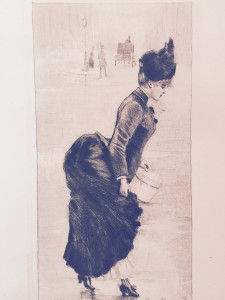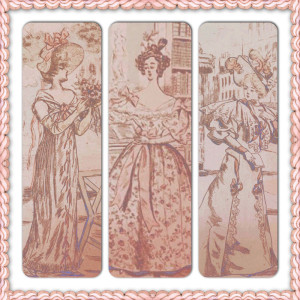 Before I researched The Road Home and The Garden Promise I thought I had a better grasp of 19th century fashion than I did. In The Last Letter, fashion wasn’t as important as was survival. Though Jeanie, Lutie, and Katherine may have lamented certain elements of clothing they lacked on the prairie (pretty silken shoes!), minute-to-minute survival took precedence over the dream of a proper bustle to lift one’s skirt to just the right height and angle.
Before I researched The Road Home and The Garden Promise I thought I had a better grasp of 19th century fashion than I did. In The Last Letter, fashion wasn’t as important as was survival. Though Jeanie, Lutie, and Katherine may have lamented certain elements of clothing they lacked on the prairie (pretty silken shoes!), minute-to-minute survival took precedence over the dream of a proper bustle to lift one’s skirt to just the right height and angle.
But it wasn’t until I was describing Katherine getting dressed in a particular scene in The Road Home that I realized I had no idea what I was talking about when it came to her underthings. Suddenly I was aware that the hoop wasn’t right for 1891. The pouffy look of the 1830’s differed from the looser early 1800’s appearance and the mutton sleeve look of the 1890’s was vastly different than the billowy shape of 1835.
 In every era there was a dominant sleeve, bodice, and skirt shape that represented the ideal look of beauty. In my mind I had sort of lumped all the “old-fashioned” looks together and really had to begin the work of sorting through how it was a woman achieved a certain “fashionable” shape. These original prints by Henri Boutet show some of the silhouettes, sleeves and necklines that were popular over time. The first drawing that shows the woman in black is outfitted in a walking costume–the height of 1885 fashion. The next three from left to right depict the fashions of 1808, 1835, and 1892.
In every era there was a dominant sleeve, bodice, and skirt shape that represented the ideal look of beauty. In my mind I had sort of lumped all the “old-fashioned” looks together and really had to begin the work of sorting through how it was a woman achieved a certain “fashionable” shape. These original prints by Henri Boutet show some of the silhouettes, sleeves and necklines that were popular over time. The first drawing that shows the woman in black is outfitted in a walking costume–the height of 1885 fashion. The next three from left to right depict the fashions of 1808, 1835, and 1892.
As I researched the underpinnings of these clothing styles I also began to consider how these “ideals” of fashion fit into Katherine and Jeanie’s world. Just because these were examples of how women should dress it didn’t mean they had the means to dress that way. And it certainly didn’t mean that a woman who was tasked with tending a farm dressed like the woman with a staff to tend her home…
I think the 1808 dress looks most comfortable… how about you?
